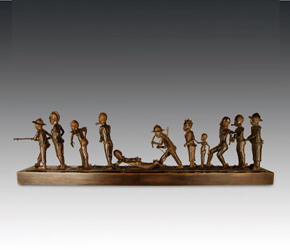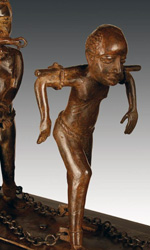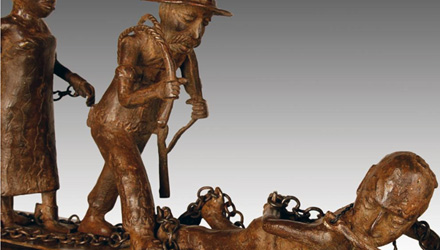Benin Bronze Slave Trade Procession
 |
|
The ancient kingdom of
 |
|
Typical of the artworks created for the royal court were human and animal figures, relief plaques, carved elephant tusks, pendants, bracelets, life size commemorative heads of Obas and queen mothers, and ceremonial objects to adorn the palace and the altars honoring Obas of the past. Many of these objects were intended as objects celebrating ancestors, as war trophies, and as focal points for sacrificial ceremonies.
The most renowned examples of
The production of bronze objects was almost always done using the “lost wax” method of casting. In lost wax methodology, a model (the statue) is carved from wax, or for hollow castings, from a thin layer of wax surrounding a clay core. A mold is then created to surround the wax statue. In turn, molten metal is poured into the mold and the wax is displaced. Finally, the mold is broken to reveal the statue. Using this method it is only possible to create a one-of-a-kind object since the mold and the wax original are destroyed as part of the production process.
The most important patron and customer for bronze sculpture was the ruler of Benin. Bronze and ivory were at the top of the scale of valuable materials and were monopolized by the Oba. With very few exceptions, castings were destined for the Oba and his closest relatives. In the beginning they were made primarily for the cult of the royal ancestors. In time, due to increasing imports of metal, production slowly expanded to include items that were accessories used by dignitaries in royal ceremonies at court or by those attempting to gain royal privileges for themselves.
In 1897 the British mounted a punitive expedition led by Admiral Sir Harry Rawson in response to the defeat of a previous British led invasion force. The British captured, burned, and looted Benin City, the capital, and for all practical purposes brought to an end the West African Kingdom of Benin. The King was sent into exile, later dying in 1914, valuable artwork was stolen, and the metal casters and artisans who previously worked under a patronage system for the king found themselves suddenly out of work.
The metal casters and artisans proved themselves to be resilient. They began to produce the same sort of work they had previously produced for the invaders and other Europeans who began to make their way to the country and before the looting could be seen adorning royal compounds. It wasn’t until after World War II that depictions of events in Benin history began to appear on the market; for example, sculptures of the Oba and his consorts being exiled during the punitive expedition and other historical illustrations like the slave trade procession.
Benin Kingdom had a long history with slavery as slaves constituted an important part of the trade relations between Benin and other countries. The
The

|
|
Download this Article: Benin Slave Trade Procession.pdf